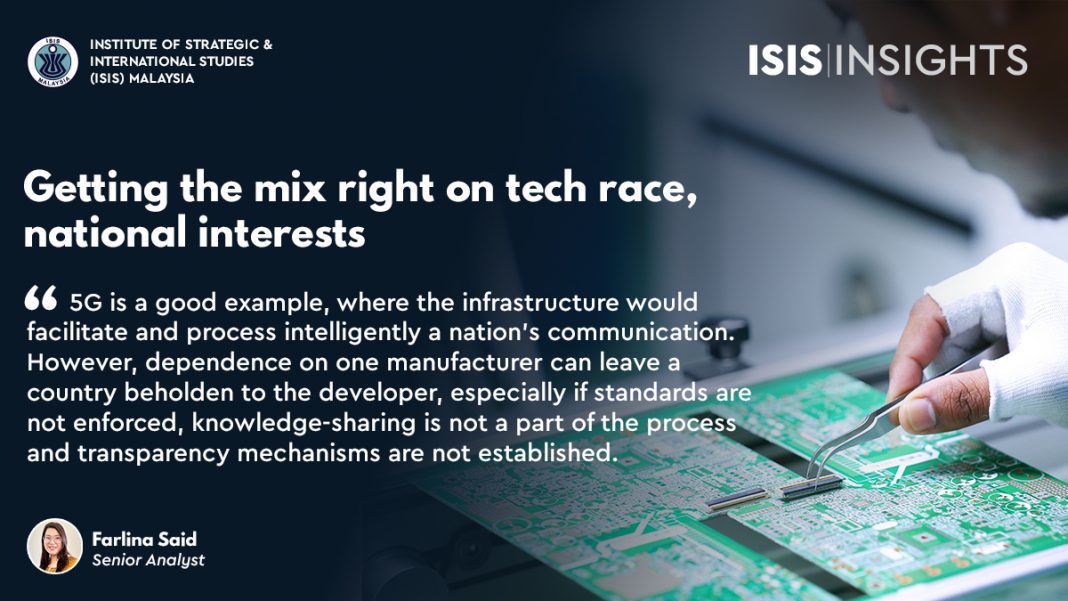Nations must navigate alliances, build domestic digital economy.
In recent years, many nations have pursued partnerships with the purpose of advancing alliances on emerging and critical technologies. For instance, the Quadrilateral Security Dialogue between the US, Japan, India and Australia has a working group on critical and emerging technology, which looks into technical standards, 5G diversification and deployment, horizonscanning and technology supply chains.
Another example is the Russia-China year of scientific, technical and innovation cooperation (2020-2021) promises engagements in military-technical fields and space technologies where the latter would include explorations in system interoperability.
The list of emerging technologies and critical technologies may not be standardised. Emerging technology generally refers to technology that has been introduced but not reached its full social, economic or scientific impact. Examples include 3D printing, 5G telecommunications, edge computing and robotics. Critical technologies are defined by governments in accordance with national interests. For instance, Australia’s definition anchors critical technologies as emerging technologies with the capacity to enhance or pose risks to “national interests” of economic prosperity, social cohesion and national security.
Countries may go through different processes to determine the list of critical and emerging technologies, such as Australia’s 63 critical technology or the UK’s selection of emerging technology priorities that include a list from Frost & Sullivan’s 300 individual technologies. The lists are bolstered by strategies aimed at developing knowledge bases, government incentives for specific sectors, advancing commercialisation for future global economic participation, forming partnerships with like-minded nations on standards or efforts to protect supply chains.
Such strategies can have an impact on alliance building or choosing partnerships, especially if technology transfers could include dual technologies that would affect national security. 5G is a good example, where the infrastructure would facilitate and process intelligently a nation’s communication. Dependence on one manufacturer can leave a country beholden to the developer, especially if standards are not enforced, knowledge-sharing is not a part of the process and transparency mechanisms are not established. Currently, diversifying players and components is at the core of 5G. This means identifying what is critical in the entire infrastructure, erecting physical and logic barriers between sensitive centres processing data and those that do not, and agreeing on cybersecurity, privacy principles and standards.
Thus, potential tech policies could trigger techno nationalist or push alliance building with countries practising like-minded values.
However, the technological landscape can be asymmetrical. In 2019, a United Nations conference on trade and development report stated that the market capitalisation value of US and China’s 70 largest digital platforms account for 90% of the global digital economy. The US and China also account for 75% of all patents related to blockchain technologies and have more than 75% of the world market for public cloud computing.
Data stored outside of the country could hamper growth in domestic digital economy, especially where data could be used to stimulate artificial intelligence or data analytics locally. Storing data abroad would also complicate digital forensics processes as international companies may not be bound by national laws and may choose to withhold support for local law enforcement. Thus, forms and variations of data sovereignty have taken place in the EU, India and Indonesia for cybersecurity and also to build local technological capabilities. However, data sovereignty is not necessarily a zero-sum game and may feature mixed approaches that could safeguard competition, create open data ecosystems while ensuring cybersecurity standards are kept.
Essentially, participation in the supply chain for future technologies is a question of available resources, knowledge bases and technological capabilities. Research, development, innovation and commercialisation are essential to lay the foundations of an economy’s participation in developing future technologies. However, the research ecosystem may be impacted by incomplete linkages between the sectors. Additionally, there can be a lack of synchronisation between the time it takes to produce such technologies and the need for companies and organisations to sustain activities until the commercialisation potential is reached.
In Malaysia, policies related to emerging and critical technologies include the 12th Malaysia Plan, national 4IR policy, digital economy blueprint, national cybersecurity strategy 2020-2024, defence white paper, national policy on science, technologyand innovation and 10-10 Malaysian science, technology, innovation and economy (MySTIE) framework. These policies have embedded emerging technology for sectors of the economy but have not prioritised the technologies for deployment.
There are waves in technological adoption. The first is in the introduction of the technology and conversations on standards, supply chain resilience and development of critical technologies among trusted allies. The second is the adoption of emerging technologies that can increase inequality within a nation, such as wages or displacement of jobs. However, such adoption and deployment of technologies can shift economic structures. Thus, building the next technological power for the new decade.





